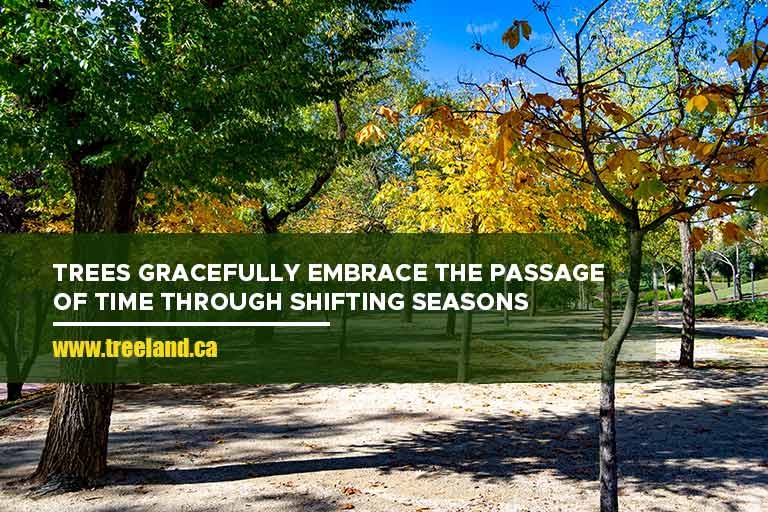In the delicate tapestry of the natural world, trees stand as steadfast sentinels, bridging the gap between earth and sky. Their perennial presence is a testament to the unyielding resilience of life, gracefully adapting to the rhythm of changing seasons. As the world around us transforms with each passing month, trees undergo an intricate dance of growth, rest, and rebirth, mirroring the cycle of life itself.
Let’s delve into the multifaceted task of caring for trees across the seasons and explore the symbiotic relationship between trees and their environment, deciphering the intricate cues that nature provides and unveiling the secrets to fostering robust growth and vitality. Whether you’re a novice gardener, an arborist, or simply an admirer of the outdoors, this guide will equip you with the knowledge and tools to become a steward of these living monuments.
How the Changing of the Seasons Affect Trees
The changing of seasons significantly affects trees in various ways, including their growth, appearance, and physiological processes. Here’s how the different seasons impact trees:
1. Spring
- Bud Break: As temperatures rise and daylight increases, trees begin to come out of dormancy. This is marked by the emergence of new buds and leaves, a process called bud break.
- Flowering and Pollination: Many trees produce flowers during spring. These flowers facilitate pollination, leading to the production of seeds and fruits later in the year.
- Photosynthesis: With the return of sunlight, trees engage in photosynthesis more actively. They absorb carbon dioxide, release oxygen, and produce energy from sunlight and water.
- Growth: Spring is a period of rapid growth for trees. New leaves, stems, and branches develop as the tree prepares to support its canopy.
2. Summer
- Canopy Growth: During summer, trees continue to grow their foliage and expand their canopy. This allows them to maximize their exposure to sunlight and further enhance photosynthesis.
- Transpiration: Trees release water vapour through small pores called stomata on their leaves. This process, known as transpiration, helps cool the tree and the surrounding environment.
- Fruit Ripening: Trees that bear fruit often see their fruits ripen during the summer months, making them ready for dispersal by animals.
- Energy Storage: The energy generated through photosynthesis is stored in the form of sugars and carbohydrates, which the tree will use during the upcoming fall and winter.
3. Fall (Autumn)
- Chlorophyll Breakdown: As daylight decreases and temperatures drop, trees begin to prepare for winter by breaking down chlorophyll, the green pigment responsible for photosynthesis. This reveals other pigments like carotenoids (yellow and orange) and anthocyanins (red and purple), resulting in the vibrant fall foliage.
- Leaf Drop: Trees shed their leaves as a survival strategy for conserving water and energy during the colder months. This process is triggered by the formation of an abscission layer that severs the connection between the leaf and the tree.
- Reduced Growth: With decreasing light and temperatures, trees slow down their growth processes in preparation for winter dormancy.
4. Winter
- Dormancy: In response to the cold temperatures, trees enter a state of dormancy. Metabolic activities are significantly reduced to conserve energy and withstand harsh conditions.
- Protection Mechanisms: Trees have various adaptations to protect themselves during winter, including thicker bark to insulate against freezing, and some tree species even produce antifreeze compounds to prevent ice crystal formation in their cells.
- Buds for Next Year: Some trees produce buds during the winter that will eventually give rise to new leaves and branches in the following spring.
Overall, the changing seasons play a crucial role in the life cycle of trees, influencing their growth, reproduction, and survival strategies.
7 Ways to Take Care of Trees When Seasons Change

Nurturing trees during changing seasons is essential for their health and growth. Here are 7 easy ways to do so:
- Watering
Adjust your watering schedule based on the changing weather conditions. During hot and dry seasons, water more frequently to prevent drought stress. In cooler seasons, reduce the frequency of watering, but ensure deep watering to promote root growth.
- Mulching
Apply a layer of organic mulch around the base of the tree to conserve moisture, regulate soil temperature, and suppress weed growth. Mulching also improves soil structure and provides essential nutrients as it breaks down over time.
- Pruning
Regularly prune dead, damaged, or diseased branches to keep the tree healthy and prevent potential hazards during storms. Pruning in the dormant season encourages new growth in the spring.
- Fertilizing
Apply a balanced and slow-release fertilizer in early spring to give the tree a nutrient boost as it enters the growing season. Avoid excessive fertilizer application, as it may lead to nutrient imbalances and harm the tree.
- Pest and disease management
Monitor the tree for signs of pests or diseases and take appropriate action if detected. Early intervention can prevent the spread of issues and keep the tree strong.
- Adjusting sunlight exposure
As the sun’s angle changes with the seasons, observe how much sunlight the tree is receiving. If the tree is getting too much direct sunlight during a hot summer, consider using shade cloth to protect it.
- Inspecting and supporting tree structure
Before and after severe weather, inspect the tree for any damage or leaning. If necessary, provide support or stabilization to help the tree recover and avoid further harm.
Remember, different tree species may have specific needs, so it’s a good idea to research the particular tree species you are nurturing to ensure you are providing the best care. Additionally, observing your tree regularly will help you understand its unique requirements and respond accordingly to changes in the environment.
The changing of seasons exerts a profound and essential influence on trees, shaping their growth, behaviour, and overall survival. From the vibrant burst of new leaves and blossoms in spring to the shedding of foliage and dormancy in winter, trees exhibit a remarkable ability to adapt to shifting environmental conditions. The interplay between temperature, sunlight, and moisture triggers intricate physiological responses within trees, leading to processes like photosynthesis, transpiration, and the allocation of resources.
Understanding the intricacies between trees and the changing seasons not only deepens our appreciation for the natural world but also underscores the delicate balance that sustains life on Earth.
Caledon Treeland is always willing to assist you if you require expert help to move your tree or if you are in need of trees and shrubs to decorate your home. Call us at 905-880-1828 and let us handle the tough job.

